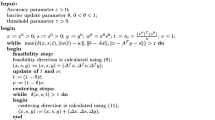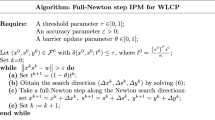Abstract
This paper is concerned with iterative methods for the linear complementarity problem (LCP) of findingx and y in Rn such thatc+Dx+y≥0, b-x≥0, andx T (c+Dx+y)=y T (b-x)=0 whenb>0. This is the LCP (M, q) withM=( D tl 0 ), which is in turn equivalent to a linear variational inequality over a rectangle. This type of problem arises, for example, from quadratic programming (QP) problems with upper and lower bounds ifD is symmetric, and from multicommodity market equilibrium problems with institutional price controls imposed ifD is not necessarily symmetric.
Iterative methods for the LCP (M, q) with symmetricM are well developed and studied using QP applications. For nonsymmetric cases withM being either an H-matrix with positive diagonals, or a Z-matrix, there exists a robust iterative method with guaranteed convergence.
This paper extends this algorithm so that the LCP (M, q) withM=( D tl 0 ) which is neither symmetric, nor an H-matrix with positive diagonals, nor a Z-matrix, can be processed when onlyD notM satisfies such properties. The case whereD is nonsymmetric is explicitly discussed.
Similar content being viewed by others
References
M. Aganagic, “Variational inequalities and generalized complementaritys problems”, Technical Report 78-11, Department of Operations Research, Stanford University (Stanford, CA, September 1978).
Byong-hun Ahn and W. W. Hogan, “On convergence of the PIES algorithm for computing equilibria”,Operations Research 30 (1982) 281–300
Byong-hun Ahn, “Solution of nonsymmetric linear complementarity problems by iterative methods”,Journal of Optimization Theory and Applications 33 (1981) 175–185
R. Chandrasekaran, “A special case of the complementary pivot problem”,Opsearch 7 (1970) 263–268
J.C. Cheng, “Analysis of a quantum price model in commodity future markets and a fair salary administration system,” Ph.D. Thesis, Department of Mathematics, MIT, (Cambridge, MA, 1975).
D.G. Christopherson, “A new mathematical method for the solution of film lubrication problems,”Institute of Mechanical Engineers, Proceedings 146 (1941), 126–135.
R.W. Cottle and M. Goheen, “A special class of large quadratic programs”, in: O.L. Mangasarian, R.R. Meyer and S.M. Robinson, eds,Nonlinear programming 3 (Academic Press, New York, 1978) pp. 361–390.
R.W. Cottle, G. Golub, and R.S. Sacher, “On the solution of large structured linear complementarity problems”,Applied Mathematics and Optimization 4 (1978) 347–363
C.W. Cryer, “The solution of quadratic programming problems using systematic overrelaxation”,SIAM Journal on Control 9 (1971) 385–392.
S. Dafermos, “Traffic equilibrium and variational inequalities”,Transportation Science 14 (1980) 52–54.
M.A. Diamond, “The solution of a quadratic programming problem using fast methods to solve systems of linear equations”,International Journal of Systems Science 5 (1974) 131–136.
M. Fiedler and V. Pták, “On matrices with nonpositive off-diagonal elements and positive principal minors”,Czechoslovak Mathematical Journal 12 (1962) 382–400.
R. Fletcher and M.P. Jackson, “Minimization of a quadratic function of many variables subject only to lower and upper bounds”,Journal of Institute for Mathematics and Its Applications 14 (1974) 159–174.
T. Hansen and A.S. Manne, “Equilibrium and linear complementarity—an economy with institutional constraints on prices”, in: G. Schwödiauer, ed.,Equilibrium and disequilibrium in economic theory (D. Reidel Publishing Company, Dordrecht, 1977) pp. 227–237.
J.M. Henderson and R.E. Quandt,Microeconomic theory: mathematical approach, 3rd edn. (McGraw-Hill Inc., New York, 1980) pp. 235–264.
W.W. Hogan, “Project independence evaluation system: structure and algorithm”,Proceedings of Symposia in Applied Mathematics 21 (1977).
L. Hurwicz, “On the problem of the integrability of demand functions”, in J.C. Chipman, ed.,Preferences, utility and demand (Harcourt Brace Javonovich, New York, 1971).
I. Kaneko, “Isotone solutions of parametric linear complementarity problems”,Mathematical Programming 12 (1977) 48–59.
S. Karamardian, “Generalized complementarity problem”,Journal of Optimization Theory and Applications 8 (1971) 161–168.
O.L. Mangasarian, “Solution of symmetric linear complementarity problems by iterative methods”,Journal of Optimization Theory and Applications 22 (1977) 465–485.
L. Mathiesen, “Efficiency pricing in a linear programming model: a case of constraints on the dual variables,”, Operations Research Report 74-108, Department of Operations Research, Stanford University (Stanford, CA, 1974).
J.J. Moré, “Classes of functions and feasibility conditions in nonlinear complementarity problems”,Mathematical Programming 6 (1974) 327–338.
A.M. Ostrowski,Solution of equations and systems of equations 2nd edn. (Academic Press, New York, 1966).
J.S. Pang, “On a class of least-element complementarity problems”,Mathematical Programming 16 (1979) 111–126.
J.S. Pang, “The implicit complementarity problem: part II”, Management Science Research Report 459, Graduate School of Industrial Administration, Carnegie-Mellon University (Pittsburgh, PA, 1980).
J. Quirk and R. Saposnik,Introduction to general equilibrium theory and welfare economics (McGraw-Hill, New York, 1968) pp. 61–64.
F. Scarpini, “Some algorithms solving the unilateral Dirichlet problem with two constraints”,Calcolo 12 (1975) 113–149.
G. Stampacchia, “Variational inequalities”, in: A. Ghizzetti, ed.,Theory and application of monotone operators, Proceedings of NATO Advanced Study Institute (Venice, Italy, 1968).
A. Tamir, “The complementarity problem of mathematical programming”, Ph.D. Thesis, Department of Operations Research, Case Western Reserve University (Cleveland, OH, 1973).
A.F. Veinott Jr, “Leastd-majorized network flows with inventory and statistical applications”,Management Science 17 (1971) 547–567.
A. Whinston, “The bounded variable problem—an application of the dual method for quadratic programming”,Naval Research Logistics Quarterly 12 (1975), 173–179.
Y. Yoo, “Iterative methods for linear complementarity problems and large scale quadratic programming problems”, M. S. Thesis Korea Advanced Institute of Science and Technology (Seoul, Korea, 1981).
Author information
Authors and Affiliations
Rights and permissions
About this article
Cite this article
Byong-Hun, A. Iterative methods for linear complementarity problems with upperbounds on primary variables. Mathematical Programming 26, 295–315 (1983). https://doi.org/10.1007/BF02591868
Received:
Accepted:
Issue Date:
DOI: https://doi.org/10.1007/BF02591868




